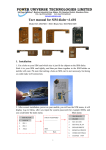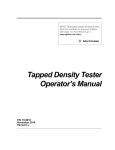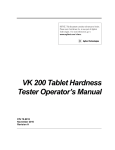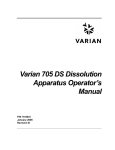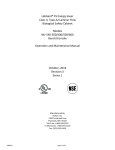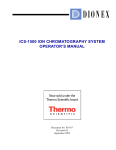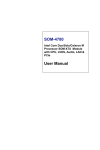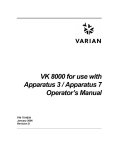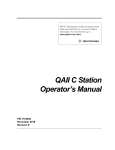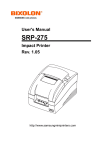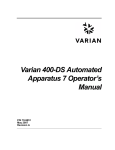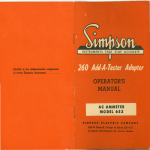Download Tapped Density Tester - Agilent Technologies
Transcript
Tapped Density Tester Operator’s Manual Agilent Technologies Notices © Agilent Technologies, Inc. 2011 Warranty No part of this manual may be reproduced in any form or by any means (including electronic storage and retrieval or translation into a foreign language) without prior agreement and written consent from Agilent Technologies, Inc. as governed by United States and international copyright laws. The material contained in this document is provided “as is,” and is subject to being changed, without notice, in future editions. Further, to the maximum extent permitted by applicable law, Agilent disclaims all warranties, either express or implied, with regard to this manual and any information contained herein, including but not limited to the implied warranties of merchantability and fitness for a particular purpose. Agilent shall not be liable for errors or for incidental or consequential damages in connection with the furnishing, use, or performance of this document or of any information contained herein. Should Agilent and the user have a separate written agreement with warranty terms covering the material in this document that conflict with these terms, the warranty terms in the separate agreement shall control. Manual Part Number 70-9069 Edition Rev A, April 2011 Printed in USA Agilent Technologies, Inc. 3501 Stevens Creek Blvd. Santa Clara, CA 95052 USA (Technical Data) and 12.212 (Computer Software) and, for the Department of Defense, DFARS 252.227-7015 (Technical Data - Commercial Items) and DFARS 227.7202-3 (Rights in Commercial Computer Software or Computer Software Documentation). Safety Notices CAUTION A CAUTION notice denotes a hazard. It calls attention to an operating procedure, practice, or the like that, if not correctly performed or adhered to, could result in damage to the product or loss of important data. Do not proceed beyond a CAUTION notice until the indicated conditions are fully understood and met. WA RNING Technology Licenses The hardware and/or software described in this document are furnished under a license and may be used or copied only in accordance with the terms of such license. Restricted Rights Legend U.S. Government Restricted Rights. Software and technical data rights granted to the federal government include only those rights customarily provided to end user customers. Agilent provides this customary commercial license in Software and technical data pursuant to FAR 12.211 A WARNING notice denotes a hazard. It calls attention to an operating procedure, practice, or the like that, if not correctly performed or adhered to, could result in personal injury or death. Do not proceed beyond a WARNING notice until the indicated conditions are fully understood and met. Tapped Density Tester Operator’s Manual Contents Figures 1 Safety 7 9 Electrical Hazards 10 Warning 11 Caution 11 Note 11 Information Symbols General 13 WEEE Directive 2 Introduction 12 14 15 Available Configurations 16 Conventions Used in this Manual USP Suitability Test 17 USP Physical Parameters 3 16 17 Setting Up the Tapped Density Tester Initial Setup 20 Unpacking Procedure Clearance 21 20 Power Cord Connection 21 Connecting the Printer 22 Mounting Platforms and Cylinders Setting the Date and Time Tapped Density Tester Operator’s Manual 19 23 23 3 Contents Hidden Key Functions 4 24 Operating the Tapped Density Tester 25 Operating the Tapped Density Tester Without a Printer Running a Test Without the Optional Printer 26 Stopping a Test 27 Operating the Tapped Density Tester with a Printer Configuring for the Number of Cylinders Used Running a Test 29 Stopping a Test 30 5 Troubleshooting and Maintenance Maintenance 32 Periodic Maintenance 26 28 28 31 32 Report Center Impact Printer 33 Installing the Cartridge Ribbon 33 Replacing the Paper Roll 34 Toggling Your Printer Online 35 Printer Self Test 35 Printer Configuration 36 Fuse Replacement 38 Troubleshooting 39 Cam Adjustment 40 6 Service and Warranty 43 Service and Warranty Information 44 Exclusions and Limitations 44 Obtaining Warranty Service 44 Warranty Limitations 45 Exclusive Remedies 45 4 Tapped Density Tester Operator’s Manual Contents Index Tapped Density Tester Operator’s Manual 47 5 Contents This page was intentionally left blank, except for this message. 6 Tapped Density Tester Operator’s Manual Figures Figure 1. Cam Diagram Tapped Density Tester Operator’s Manual 41 7 Figures This page was intentionally left blank, except for this message. 8 Tapped Density Tester Operator’s Manual Tapped Density Tester Operator’s Manual 1 Safety Electrical Hazards 10 WEEE Directive 14 The Tapped Density Tester has been carefully designed so that when used properly you have an accurate, fast, flexible, and safe instrument. If the equipment is used in a manner not specified by the manufacturer, the protection provided by the equipment may be impaired. The Tapped Density Tester is operated in conjunction with equipment that uses aqueous liquids. Unskilled, improper, or careless use of this instrument can create shock hazards, fire hazards, or other hazards which can cause death, serious injury to personnel, or severe damage to equipment and property. Information on safety practices is provided with your instrument and operation manuals. Before using your instrument or accessories, you must thoroughly read these safety practices. Observe all relevant safety practices at all times. Agilent Technologies 9 1 Safety Electrical Hazards The Tapped Density Tester contains electrical circuits, devices, and components operating at dangerous voltages. Contact with these circuits, devices, and components can cause death, serious injury, or painful electric shock. Panels or covers that are retained by fasteners which require the use of a tool for removal may be opened only by Agilent-trained, Agilent-qualified, or Agilent-authorized service engineers. Consult the manuals or product labels supplied with the Tapped Density Tester to determine which parts are operator-accessible. Application of the wrong supply voltage, connection of the instrument to an incorrectly wired supply outlet, or lack of proper electrical grounding can create a fire hazard or a potentially serious shock hazard and could seriously damage the instrument and any attached ancillary equipment. Always use a three-wire outlet with ground connection which is adequately rated for the load. The installation must comply with local, state, and federal safety regulations. Do not connect the instrument to the main power supply until you have made sure that the operating voltage is correctly set for the main power supply in the specific outlet in your laboratory to which the equipment will be connected. 10 Tapped Density Tester Operator’s Manual Safety 1 Warning WA RNING A ‘Warning’ message appears in the manual when failure to observe instructions or precautions could result in death or injury. Read all warnings and cautions carefully and observe them at all times. Caution CAUTION A ‘Caution’ message appears in the manual when failure to observe instructions could result in damage to equipment (Agilent supplied and / or other associated equipment). Note NOT E A ‘Note’ appears in the manual to give advice or information. Tapped Density Tester Operator’s Manual 11 1 Safety Information Symbols I Switches main power on 0 Switches main power off Indicates single-phase alternating current Indicates the product complies with the requirements of one or more European Union (EU) directives Indicates specific equipment meets consensus-based standards of safety to provide assurance, required by OSHA, that these products are safe for use in the workplace for North America Indicates that this product must not be disposed of as unsorted municipal waste 12 Tapped Density Tester Operator’s Manual Safety 1 General CE Compliant Products The Tapped Density Tester has been designed to comply with the requirements of the Electro-magnetic Compatibility (EMC) Directive and the Low Voltage Directive (LVD) of the EU. Agilent, Inc. has confirmed that each product complies with the relevant directives by testing a prototype against the prescribed European Norm (EN) standards. Proof that a product complies with the directives is indicated by: • the CE marking appearing on the rear of the product. • the documentation package that accompanies the product containing a copy of the declaration of conformity. This declaration is the legal declaration by Agilent, Inc. that the product complies with the directives and also shows the EN standards to which the product was tested to demonstrate compliance. The declaration of conformity is signed by the representative of the manufacturing plant. cTUVus - U.S. and Canadian Product Approvals The Tapped Density Tester has been designed to comply with North American safety requirements. This product has been tested and certified for the North American market by TUV Rheinland of North America, Inc. The TUVus mark signifies that this product has been tested to U.S. standards and certified for the U.S. market. The cTUV mark signifies that this product has been tested to Canadian standards and certified for the Canadian market. When the two marks are coupled, the cTUVus mark signifies that this product has been tested to standards and certified for both markets. Tapped Density Tester Operator’s Manual 13 1 Safety WEEE Directive All Agilent products that are subject to the WEEE directive shipped after August 13, 2005 are compliant with the WEEE marking requirements. Such products are marked with the “crossed out wheelie bin” WEEE symbol shown on page 12 in accordance with European Standard EN 50419. This symbol on the product or on its packaging indicates that this product must not be disposed of as unsorted municipal waste. The separate collection and recycling of your waste equipment at the time of disposal will help to conserve natural resources and ensure that it is recycled in a manner that protects human health and the environment. For more information on collection, reuse, and recycling systems, please contact your local/regional waste administration, your local distributor, or Agilent, Inc. 14 Tapped Density Tester Operator’s Manual Tapped Density Tester Operator’s Manual 2 Introduction Available Configurations 16 Conventions Used in this Manual USP Suitability Test 17 USP Physical Parameters 17 16 The Tapped Density Tester provides a standardized, reproducible method for measuring the tapped or bulk density of powdered, granulated, or flaked materials. This is important since changes in the tapped density of raw materials can affect their performance during the manufacturing process. For example, powders which do not meet the normal incoming QC tapped density specification might tend to clog tablet presses and disrupt the manufacturing process. WA RNING The Tapped Density Tester contains electrical circuits, devices, and components operating at dangerous voltages. Contact with these circuits, devices and components can cause death, serious injury, or painful electric shock. CAUTION Panels or covers that are retained by fasteners which require the use of a tool for removal may be opened only by Agilent-trained, Agilent-qualified, or Agilent-authorized service engineers. Agilent Technologies 15 2 Introduction Available Configurations The Tapped Density Tester is available in single-platform and dual-platform models. Standard configurations include one or two 100 mL funnel-top cylinders and platforms as appropriate. Optionally, 10, 25, 50, 250, and 500 mL cylinders and platforms are available. All can be interchanged with no mechanical modification to the instrument. In addition to the standard USP design with a drop of 14 ± 2 mm, an ASTM version is also available with a 3 mm ± 10% drop, no cylinder rotation, and a 250 taps per minute nominal speed. This version is used for industrial applications such as chemicals and powdered metals. Conventions Used in this Manual • Items you are asked to press are in bold. For example, “press H on the keypad”. NOT E 16 Remember to return the warranty card supplied with this manual. Completing and returning the card ensures your right to protection under the terms and conditions of your warranty. It also enables us to better assist you in the event of any problems. Additionally, it guarantees you will be informed of any issues that arise concerning your equipment, such as upgrades, retrofits, or regulatory changes. Tapped Density Tester Operator’s Manual Introduction 2 USP Suitability Test Before initial use of any dissolution instrument, and periodically thereafter, the USP requires that you run an Performance Verification Test with USP Dissolution Calibrators. These calibrator tablets are available from the USP at the following address: USP-NF Reference Standards 12601 Twinbrook Parkway Rockville, MD 20852 301.881.0666 Complete instructions come with the calibrator tablets. Calibration tests can be very sensitive to factors such as paddle or vessel misalignment, vessel shape, vibration of the system, age of the calibrator tablets and reference standards, and many other factors. USP Physical Parameters In addition to the Apparatus Suitability Test, several physical parameters must be monitored, such as shaft wobble, centering, speed, and shaft verticality. A Certificate of Inspection is included with all dissolution apparatus. Contact the Dissolution Systems Service Department for more information on USP Physical Parameters. Tapped Density Tester Operator’s Manual 17 2 Introduction This page was intentionally left blank, except for this message. 18 Tapped Density Tester Operator’s Manual Tapped Density Tester Operator’s Manual 3 Setting Up the Tapped Density Tester Initial Setup 20 Power Cord Connection 21 Setting the Date and Time 23 Hidden Key Functions 24 Agilent Technologies 19 3 Setting Up the Tapped Density Tester Initial Setup Complete the following sections to initially set up the Tapped Density Tester and all other system components. Unpacking Procedure Complete these steps to safely unpack and set up your equipment: 1 Open each carton and check the contents for damage which may have occurred during shipping. Shipping damage rarely occurs, but if it does contact both the carrier who delivered the instruments and the Dissolution Systems Service Department. Though claims for damage should be filed with the carrier, we can help you file a claim. 2 Carefully remove the Tapped Density Tester base unit from the shipping carton. Place it on a clean, dry, level area of your benchtop within four feet (122 cm) of a grounded electrical outlet. WA RNING The electrical connection at the back of the Tapped Density Tester is the primary disconnect for the instrument. The tester should be positioned to allow accessibility to the power cord for easy disconnection. 3 Ensure the power is off. WA RNING Before plugging the Tapped Density Tester into any power outlet, ensure the instrument is properly configured for the voltage provided. Check the serial number tag on the rear panel of the instrument to confirm the voltage requirement. 4 Connect the power cord (found in the instrument accessory kit) between the receptacle on the rear panel and an electrical outlet of the appropriate voltage. 20 Tapped Density Tester Operator’s Manual Setting Up the Tapped Density Tester 3 5 Turn on the Tapped Density Tester. The LED on the front panel illuminates. If not, ensure the unit is securely plugged in and there is power at the outlet. If the unit still fails to respond, see “Troubleshooting” on page 39 or call the Dissolution Systems Service Department. Clearance 1 Prepare the area where the equipment is to be located. 2 Ensure a minimum clearance of 35 cm above the unit and 10 cm at the rear and on both sides of the Tapped Density Tester. Approximately 50 x 60 cm total bench space is required. For the optional Acoustic Cabinet, 84 x 44 x 46 cm of bench space is required. 3 Orient the Tapped Density Tester and all other system components appropriately. Power Cord Connection 1 Before connecting the power cord(s), verify the correct voltage has been selected. 2 Ensure the main power switch in the rear panel AC power connector is in the off position. 3 Connect or verify connection of the female end of the AC power cord into the power connector on the Tapped Density Tester rear panel. 4 Plug the cord into an AC electrical supply of the same voltage as stamped on the instrument’s identification tag. Tapped Density Tester Operator’s Manual 21 3 Setting Up the Tapped Density Tester Connecting the Printer If your unit is equipped with the optional Report Center Printer, complete the following steps to connect it to your Tapped Density Tester: NOT E If your Tapped Density Tester came equipped with a Star SP500-series printer, please refer to the SP500 Series User’s Manual for setup instructions. 1 Remove the printer from the shipping carton. 2 Place it on a clean, dry, level area of your benchtop to the left of your Tapped Density Tester. 3 Connect the printer cable between the rear of the printer and the port on the right-side panel of the Tapped Density Tester. 4 Connect the AC power adapter between the jack on the rear of the printer and an electrical outlet of the appropriate voltage. Toggle the printer online by pressing the printer toggle switch to the OnLine / Off Line position. The Ready LED illuminates. If not, ensure the printer is securely plugged in and there is power at the outlet. If the device still fails to respond, see “Troubleshooting” on page 39 or call the Dissolution Systems Service Department. 22 Tapped Density Tester Operator’s Manual Setting Up the Tapped Density Tester 3 Mounting Platforms and Cylinders Complete the following steps to mount platforms and cylinders: 1 Insert the shafts on the cylinder platforms into the sleeves on top of the unit. The cylinder platforms simply drop into the sleeves and should be free to move up and down. NOT E Each side of the dual Tapped Density Tester is calibrated to the corresponding platform. Ensure the correct platform is placed into the proper sleeve (left and right). 2 Slide the bases of the graduated cylinders onto the cushioned platforms. The base of each cylinder is held under the platform and secured by the pair of spring clips. Setting the Date and Time The Tapped Density Tester comes equipped with a battery-backed up clock which stores the date and time. If your unit is equipped with the Report Center Printer, the date and starting time print on the report. If applicable, complete the following steps to set the date and time: 1 Press SET CLOCK. The current date (in mm/dd/yy format) and time (in 24-hour format) display alternately. 2 To accept the current date and time, press CLEAR. The test duration displays and no further action is required. To change the date and time, press SET CLOCK again. The date displays in mm/dd/yy format. 3 To accept the date as it displays, press ENTER. The time displays in 24-hour format. To change the date, enter the new value and press ENTER. The time displays in 24-hour format. 4 To accept the time as it displays, press ENTER. The test duration displays. To change the time, enter the new value and press ENTER. The test duration displays. Tapped Density Tester Operator’s Manual 23 3 Setting Up the Tapped Density Tester Hidden Key Functions Hidden keys can be accessed only when the Printer On LED is not illuminated, indicating that the printer is disabled, and the motor is running. Toggle PRINT to enable or disable the printer. In order to enable the PRINT key, press CLEAR > 9. In the following table, CLEAR > (function) indicates you should press CLEAR and then the function key. Table 1 24 Hidden Key Functions Key Sequence Function CLEAR > 1 Use this key sequence to indicate a single cylinder. CLEAR > 2 Use this key sequence to indicate dual cylinders. CLEAR > 6 Use this key sequence to enable the PCB display. CLEAR > 7 Use this key sequence to indicate the Tapped Density Tester. CLEAR > 9 Use this key sequence to enable the PRINT key. CLEAR > 0 Use this key sequence to disable the PRINT key. Tapped Density Tester Operator’s Manual Tapped Density Tester Operator’s Manual 4 Operating the Tapped Density Tester Operating the Tapped Density Tester Without a Printer 26 Operating the Tapped Density Tester with a Printer 28 Agilent Technologies 25 4 Operating the Tapped Density Tester Operating the Tapped Density Tester Without a Printer WA RNING The Tapped Density Tester produces excessive noise levels. During operation consider wearing approved hearing protection devices or operating the unit in the optional acoustic cabinet. If your unit is equipped with a printer, see “Operating the Tapped Density Tester with a Printer” on page 28. Running a Test Without the Optional Printer Complete the following steps to run a test using a Tapped Density Tester not equipped with a Report Center Printer: 1 Ensure the PRINT key is disabled. See “Hidden Key Functions” on page 24 for instructions on how to disable the PRINT key. 2 Select the mode of operation, either timer or counter, by pressing TIME COUNT. This key toggles the unit between the two operating modes. The Timer LED illuminates to indicate the timer option is selected. The Counter LED illuminates to indicate the counter option is selected. 3 Enter either the number of taps (up to 999,999) or the time duration (in hh:mm:ss format) as applicable and press ENTER. Once entered, the test duration is saved by the unit and does not need to be reset unless you want to change it. To change the duration, enter the new value and press ENTER. 4 Pass the product through a number 18 sieve (1.00 mm sieve opening), if appropriate, and weigh the product for each cylinder separately. 5 Load the product into the cylinders and level it without compacting, if necessary. 6 Press START STOP to begin. The time duration or number of taps count down on the display screen and the test stops automatically when 0 is reached. The display automatically resets to the original set value preparing the instrument for the next test. 26 Tapped Density Tester Operator’s Manual Operating the Tapped Density Tester 4 7 To calculate the tapped density, use the following equation: initial weight tapped density = ------------------------------final volume Stopping a Test When running a test on a Tapped Density Tester without a printer, you can stop the test by pressing START STOP. The cylinders stop immediately and the display returns to the original test length setting. Tapped Density Tester Operator’s Manual 27 4 Operating the Tapped Density Tester Operating the Tapped Density Tester with a Printer WA RNING The Tapped Density Tester produces excessive noise levels. During operation consider wearing approved hearing protection devices or operating the unit in the optional acoustic cabinet. If your unit is not equipped with a printer, see “Operating the Tapped Density Tester Without a Printer” on page 26. Configuring for the Number of Cylinders Used Complete the following steps to configure your printer-equipped Tapped Density Tester for the number of cylinders in use: 1 Ensure the PRINT key is enabled. See “Hidden Key Functions” on page 24 for instructions on how to enable the PRINT key. 2 Ensure the Printer On LED is not illuminated. If the LED is illuminated, press PRINT to disable the printer. 3 Press START STOP. The instrument begins tapping. 4 Use the following keystroke combination depending on the number of cylinders you wish to specify. • CLEAR > 1 for one cylinder • CLEAR > 2 for two cylinders If you select two cylinders, you are prompted for two weights when you begin the test and two volumes at the end of the test. 5 Press START STOP. The instrument stops tapping. 6 Press PRINT to enable the printer. The Printer On LED illuminates. The next time you press START STOP, with the printer enabled, the appropriate number of initial weights and final volumes are requested based on the number of cylinders specified. 28 Tapped Density Tester Operator’s Manual Operating the Tapped Density Tester 4 Running a Test If your Tapped Density Tester is equipped with the optional Report Center Printer, you can print a report at the end of each test to document the date, starting time, mode selected and set values, initial weights, final volumes and tapped densities. If the Printer On LED is illuminated, the printer is enabled. Press PRINT to enable or disable the printer. Complete the following steps to operate your Tapped Density Tester with Report Center Printer: 1 Ensure the printer is enabled. When the printer is enabled, the Printer On LED illuminates. 2 Toggle the printer online by pressing the printer toggle switch to the OnLine / Off Line position. The Ready LED illuminates. 3 Select the mode of operation, either timer or counter, by pressing TIME COUNT. This key toggles the unit between the two operating modes. The Timer LED illuminates to indicate the timer option is selected. The Counter LED illuminates to indicate the counter option is selected. 4 Enter either the number of taps (up to 999,999) or the time duration (in hh:mm:ss format) as applicable and press ENTER. Once entered, the test duration is saved by the unit and does not need to be reset unless you want to change it. To change the duration, enter the new value and press ENTER. 5 Pass the product through a number 18 sieve (1.00 mm sieve opening), if appropriate, and weigh the product for each cylinder separately. 6 Load the product into the cylinders and level it without compacting, if necessary. 7 Press START STOP. You are prompted to enter the initial weight (in grams) of the product in the cylinder. Up to two weights can be entered depending on the number of cylinders used (see “Configuring for the Number of Cylinders Used” on page 28). The following is a summary of what displays after you press START STOP but before the cylinders begin to tap: Tapped Density Tester Operator’s Manual 29 4 Operating the Tapped Density Tester • The numeral 1 displays on the display screen alternating with the last initial weight entered for the product in cylinder 1. Press ENTER to accept the displayed value or enter the new initial weight and press ENTER. If you have indicated one cylinder, the cylinder begins to tap. • If you have indicated two cylinders, the numeral 2 flashes on the display screen alternating with the last initial weight entered for the product in cylinder 2. Press ENTER to accept the displayed value or enter the new initial weight and press ENTER. The cylinders begin to tap. 8 At the end of the test, when the cylinders have stopped tapping, the Tapped Density Tester requests ending volumes for the products in each cylinder as it did for starting weights. 9 After the ending volume for the last cylinder has been entered, the Report Center prints a test report and the calculated tapped density for the products. Stopping a Test 1 When running a test on a Tapped Density Tester equipped with a printer, you can stop the test by pressing START STOP. The cylinders stop immediately and the display requests the ending volumes for the products as described above. 2 Enter the ending volumes and press ENTER for each cylinder as applicable. The printer prints a test report and calculates tapped density for the products even though the test was stopped prematurely. 30 Tapped Density Tester Operator’s Manual Tapped Density Tester Operator’s Manual 5 Troubleshooting and Maintenance Maintenance 32 Report Center Impact Printer Fuse Replacement 38 Troubleshooting 39 33 Agilent Technologies 31 5 Troubleshooting and Maintenance Maintenance Periodic Maintenance Periodic maintenance needs may vary depending on frequency of instrument usage. • Immediately wipe all spills or errant materials from the exterior of the instrument or any exposed part using a clean cloth and plain water. • Store all tapped density cylinders properly to reduce the chance of breakage. Monthly Maintenance • Inspect the platform bushings for excessive wear. • Inspect the platform cap drive bar for excessive loosening. • Inspect the platform clips for excessive loosening. • Check the integrity of the neoprene insert. • Clean the outside of the tester with a damp cloth. Annual Maintenance WA RNING Panels or covers that are retained by fasteners which require the use of a tool for removal may be opened only by Agilent-trained, Agilent-qualified, or Agilent-authorized service engineers. • Inspect all electrical connections for corrosion and damage. • Clean the inside and outside of the tester with a damp cloth. • Check belt tension—total deflection should not exceed 1/2 inch (1.3 cm). 32 Tapped Density Tester Operator’s Manual Troubleshooting and Maintenance 5 Report Center Impact Printer NOT E If your Tapped Density Tester came equipped with a Star SP500-series printer, please refer to the SP500 Series User’s Manual for maintenance instructions. The following is helpful information for using your impact printer. Installing the Cartridge Ribbon If the printer is used infrequently, the print impression sometimes becomes weak because the ribbon dries out. If the printed material is difficult to read and you suspect this is the cause of the problem, advance to a new section of the ribbon by pressing the printer toggle switch to the Paper feed position. If the printing is still faint, replace the cartridge. To install the cartridge: 1 Toggle the printer off line by pressing the printer toggle switch to the OnLine / Off Line position. When the printer is off line, the Ready LED does not illuminate. 2 Eight small grooves are embossed on the printer cover. Gently push on these grooves to tilt the cover. When the printer cover is tilted up, you can lift it completely off. 3 Push down on the right side of the ribbon cartridge (marked PUSH) and remove the old cartridge. 4 Install the new cartridge. If there is already paper in the printer, hold the cartridge between your thumb and index finger, slide it over the paper and into the printer compartment. Ensure the paper is between the ribbon cartridge and the ink ribbon. Ensure the ribbon cartridge is inserted firmly to prevent weak or irregular printing. The cartridge must be properly seated and aligned for the best printing. 5 Turn the cartridge knob (marked by an arrow) clockwise to stretch the ribbon taut. 6 Replace the cover. Tapped Density Tester Operator’s Manual 33 5 Troubleshooting and Maintenance 7 Toggle the printer online by pressing the printer toggle switch to the OnLine / Off Line position. The Ready LED illuminates. 8 Replace the paper if necessary. If you get ribbon ink on the printer’s plastic cover, remove it immediately. Once it dries, it becomes difficult to remove. Replacing the Paper Roll 1 Toggle the printer off line by pressing the printer toggle switch to the OnLine / Off Line position. When the printer is off line, the Ready LED does not illuminate. 2 Grasp the paper roll cover firmly by the grooves on the side and the front edge. Pull outward to remove the cover. 3 Press the printer toggle switch to Paper feed to advance the paper approximately one inch beyond the paper cutter. 4 Using scissors, cut the paper feeding to the printer and remove the paper roll. 5 Pull the remaining paper through the printer mechanism. Pull the paper from the front (paper cutter side). Pulling the paper out of the back of the printer will damage the print mechanism. 6 Unroll several inches of paper on the new roll. 7 Cut a straight edge on the paper roll, if it is jagged, to facilitate the entry of the paper into the printer. 8 Slide the paper through the slot connecting the paper compartment and the printer compartment. You can slide it in approximately 1/4 inch before it stops. 9 While holding the paper in place, press the printer toggle switch to the Paper feed position and hold until approximately one inch of paper has emerged from the top of the printer. WA RNING Ensure the roll of paper feeds squarely. If it does not, the paper can jam and possibly damage the printer mechanism. 10 Release the printer toggle switch. 34 Tapped Density Tester Operator’s Manual Troubleshooting and Maintenance 5 11 Turn the paper roll to take up any slack in the paper feeding to the printer. 12 Place the paper roll into the paper compartment. 13 Replace the paper roll cover. If the cover is difficult to remove or replace, the left and right edges can be trimmed or shaved with a utility knife allowing the cover to slide easier. 14 Toggle the printer online by pressing the printer toggle switch to the OnLine / Off Line position. The Ready LED illuminates. Toggling Your Printer Online Complete these steps to toggle your printer online: 1 Toggle the printer online by pushing the printer toggle switch to the OnLine / Off Line position. 2 Release the switch and it returns to the center position. The Ready LED illuminates and a READY message prints if the PRINT READY command has not been turned off. See “Printer Configuration” on page 36 for instructions on turning on and off the PRINT READY command. When you first turn on the printer, it prints a READY message to assure you that the built-in microprocessor is operating properly. When you turn off the printer, wait at least three seconds before turning it back on. Printer Self Test You can test the print head and ribbon only after inserting paper. Do not attempt to print without paper. Follow these steps to perform a printer self test: 1 Unplug the AC power adapter from the electrical outlet. 2 Press and hold the printer toggle switch in the Paper feed position. 3 Plug the AC power adapter into the electrical outlet. Tapped Density Tester Operator’s Manual 35 5 Troubleshooting and Maintenance 4 Hold the printer toggle switch until printing begins. The printer prints a list of the current configuration settings and performs a continuous print test. 5 Press the printer toggle switch to the OnLine / Off Line position to stop the printing operation. 6 The printer is ready to resume normal operation. Printer Configuration NOT E The printer configuration is set by the factory. This procedure should be performed only if the printer displays erroneous characters. Contact the Dissolution Systems Service Department for assistance, if necessary. 1 Unplug the AC power adapter from the electrical outlet. 2 Press and hold the printer toggle switch in the OnLine / Off Line position while plugging in the AC power adapter to the electrical outlet. Hold the printer toggle switch in the OnLine / Off Line position for six seconds after the AC power adapter is replaced, then release the switch. 3 The printer should print: *** SETUP MENU *** and CONFIGURE... [NEXT/OK]. If this message does not print, repeat steps 1 and 2. 4 The printer toggle switch is used to complete the configuration. Pressing the left side of the printer toggle switch selects NEXT to advance to the next menu item. Pressing the right side of the printer toggle switch selects OK to accept what is stated on this line of the menu item. Each time the switch is pressed, another part of the menu prints. Allow the printer to finish printing before pressing the switch again. See the table of commands on the following page. NOT E 36 The printout is easier to read if the printer cover is removed. Tapped Density Tester Operator’s Manual Troubleshooting and Maintenance Table 2 5 Printer Commands *** SETUP MENU*** CONFIGURE [NEXT/OK] Press NEXT to avoid configuration CUSTOM [NEXT/OK] Press OK to enter custom mode ***CUSTOM MENU*** PRINT CUSTOM SETUP [NEXT/OK] Press NEXT AUTO SEQ = NO [NEXT/OK] Press OK ZERO = Ø [NEXT/OK] Press OK POUND SIGN = # [NEXT/OK] Press OK _(UNDERSCORE) [NEXT/OK] Press OK ONLINE/OFFLINE = YES [NEXT/OK] Press OK EXT CH SET = NO Press OK [NEXT/OK] PRINT READY = YES [NEXT/OK] Press NEXT PRINT READY = NO [NEXT/OK] Press OK READY... Your printer is now configured correctly. Tapped Density Tester Operator’s Manual 37 5 Troubleshooting and Maintenance Fuse Replacement WA RNING The Tapped Density Tester contains electrical circuits, devices, and components operating at dangerous voltages. Contact with these circuits, devices, and components can cause death, serious injury, or painful electric shock. Panels or covers that are retained by fasteners which require the use of a tool for removal may be opened only by Agilent-trained, Agilent-qualified, or Agilent-authorized service engineers. Follow these steps to replace the fuse: 1 Before checking or attempting to replace a fuse, unplug the Tapped Density Tester and remove the power cord from the unit. 2 Press the release tab on the fuse holder located in the power entry module with the blade of a small screwdriver or equivalent. 3 Upon release, slide the holder out of the power entry module. 4 Remove the old fuse and insert the new fuse. 5 Slide the holder back into the power entry module and push until it locks into place. 6 Replace the power cord. WA RNING 38 Never replace a fuse with one of a higher amperage rating. Doing so may compromise the safety margin and could result in damage to the instrument or personal injury. Tapped Density Tester Operator’s Manual Troubleshooting and Maintenance 5 Troubleshooting We can assist you if you experience problems or have questions concerning your Tapped Density Tester. Many problems can be traced to simple sources and are easily solved. Following is a troubleshooting guide which may help you. The Dissolution Systems Service Department can be reached at 800.229.1108 (within the USA) or 919.677.1108 (outside the USA). You can send a fax to 919.677.1138. You may also e-mail the Dissolution Systems Service Department at [email protected]. Table 3 Troubleshooting Problem Possible Cause Suggested Solution The LED does not illuminate. There is no power at the outlet. Ensure the outlet has power going to it. The unit is not plugged in. Ensure the unit is securely connected to an electrical outlet. The fuse is blown (open). Replace the fuse. See “Fuse Replacement” on page 38. The motor or gear box is faulty. Contact the Dissolution Systems Service Department. The drive belt is broken or loose. Check the belt tension. If the total deflection exceeds 1/2 inch (1.3 cm), tighten the belt. The unit does not tap or taps sporadically. If the belt is broken, contact the Dissolution Systems Service Department. The test length is incorrect. In count mode, the display does not count down when tapping occurs. The wrong operating mode may be selected. Set the proper mode (counter or timer). See “Running a Test” on page 26 and page 29. The micro switch is not making contact. Contact the Dissolution Systems Service Department. The micro roller switch needs to be adjusted. Adjust the height of the switch so that it is depressed fully when the drive bar rotates. The micro roller switch is faulty. Contact the Dissolution Systems Service Department. Tapped Density Tester Operator’s Manual 39 5 Troubleshooting and Maintenance Table 3 Troubleshooting Problem Possible Cause Suggested Solution The platforms do not spin, spin less than 5 revolutions per minute or spin greater than 15 revolutions per minute. The drop cams are out of calibration. Adjust the drop cam. See “Cam Adjustment” below. The graduated cylinder has excessive wobble at the top of the cylinder. The bushing platform is worn. Contact the Dissolution Systems Service Department. The optional Report Center Printer does not function. The printer is disabled. Enable the printer. See “Hidden Key Functions” on page 24. There is no power at the outlet. Ensure the outlet has power going to it. The printer is not plugged in. Ensure the printer is securely connected to an electrical outlet. The printer is off line. Toggle the printer toggle switch online. See “Toggling Your Printer Online” on page 35. Cam Adjustment WA RNING NOT E Panels or covers that are retained by fasteners which require the use of a tool for removal may be opened only by Agilent-trained, Agilent-qualified, or Agilent-authorized service engineers. Adjusting the cam is a delicate procedure. It takes only a slight movement to make a difference in the speed of the rotations. 1 Remove any platforms and cylinders. 2 Remove the side covers and the top cover of the tester. 3 Locate the set screw on the cam which requires adjustment and loosen it slightly. 4 Adjust the cam by moving it gently to the left or right depending on the rotation problem. If the rotations per minute are too low, move 40 Tapped Density Tester Operator’s Manual Troubleshooting and Maintenance 5 the cam to the left. If the rotations per minute are too high, move the cam to the right. 5 Retighten the set screw and replace the top cover. 6 Replace the side covers. Figure 1 Tapped Density Tester Operator’s Manual Cam Diagram 41 5 Troubleshooting and Maintenance This page was intentionally left blank, except for this message. 42 Tapped Density Tester Operator’s Manual Tapped Density Tester Operator’s Manual 6 Service and Warranty Service and Warranty Information 44 The warranty is provided by Agilent Technologies, Inc. or one of its authorized representatives. Agilent Technologies 43 6 Service and Warranty Service and Warranty Information Agilent dissolution products carry a one-year warranty on parts and labor. The Dissolution Systems Service Department (or one of its representatives) will, at its option, either repair or replace any mechanical and electrical components in your instrument which prove to be defective. During the first year of warranty coverage, there is no charge for the labor to repair your unit. The Dissolution Systems Service Department (or one of its representatives) will determine the best site to repair the unit, either onsite or returned to Agilent Technologies, Inc. Any onsite warranty services are provided only at the initial installation point. Installation and onsite warranty services are available only in Dissolution Systems service travel areas. Exclusions and Limitations Excluded from this warranty are expendable or consumable items such as, but not limited to, paddles, baskets, vessels, and acrylic water baths. Also excluded are defects from improper or inadequate maintenance by the customer, user-induced chemical action or contamination, unauthorized modification or misuse, and improper site preparation and maintenance. Operation of software is not warranted to be uninterrupted or error-free. Obtaining Warranty Service To obtain warranty service in the United States, contact the Dissolution Systems Service Department at 800.229.1108 to obtain authorization to return units for repair. At the option of the customer, onsite warranty service is available, but travel charges may be incurred. The customer should prepay all shipping charges for products returned to the Dissolution Systems Service Department (unless otherwise authorized), and Agilent Technologies, Inc. will pay all charges for return to the customer. 44 Tapped Density Tester Operator’s Manual Service and Warranty 6 Warranty Limitations Agilent Technologies, Inc. makes no other warranty, either express or implied, with respect to this product. Specifically disclaimed are any implied warranties of merchantability and fitness for a particular use. In no event will Agilent Technologies, Inc. be liable for any indirect, incidental, or consequential damages arising from the use of this product. This warranty gives you specific legal rights which may vary from state to state or province to province, so you may have other rights and some of these exclusions may not apply to you. Exclusive Remedies The remedies provided herein are the customer’s sole and exclusive remedies. In no event shall Agilent Technologies, Inc. or its representatives be liable for any direct, indirect, special, incidental, or consequential damages, whether based on contract, tort, or any other legal theory. Some states or provinces do not allow the exclusion or limitation of incidental or consequential damages, so the above limitation or exclusion may not apply to you. Tapped Density Tester Operator’s Manual 45 6 Service and Warranty This page was intentionally left blank, except for this message. 46 Tapped Density Tester Operator’s Manual Index C O Cartridge Ribbon, 33 Clearance, 21 Conventions, 16 cylinders, 23 Obtaining Warranty Service, 44 Operating with a printer, 28 Operating without a printer, 26 D date/time clock, setting, 23 E Exclusions, 44 Exclusive Remedies, 45 F Fuse Replacement, 38 H hidden key functions, 24 I P Periodic Maintenance, 32 platforms, 23 Power Cord Connections, 21 Printer Configuration, 36 printer self test, 35 printer, toggling online, 35 R Report Center printer, 33 S self test, printer, 35 Service, 44 stopping a test, 27, 30 Initial Setup, 20 installing the printer cartridge ribbon, 33 T L U Limitations, 44 Unpacking Procedure, 20 unpacking your equipment, 20 USP Physical Parameters, 17 USP Suitability Test, 17 M Maintenance, 32 Periodic, 32 Monthly Maintenance, 32 mounting cylinders, 23 mounting platforms, 23 troubleshooting, 39 W Warranty, 44 Warranty Limitations, 45 Tapped Density Tester Operator’s Manual 47 Index This page was intentionally left blank, except for this message. 48 Tapped Density Tester Operator’s Manual

















































